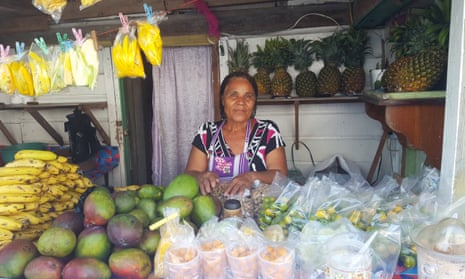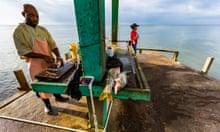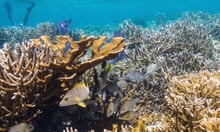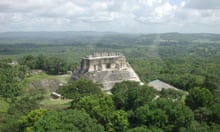A pair of young farmhands wait for a ride at an idle junction under a coconut palm on a blistering day in south Belize. A short drive east is a fishing village of Garifunas – mixed-race descendants of African slaves and indigenous Arawaks – while along the highway to the west are clusters of Mayan thatched huts.
It’s too hot to walk the few miles to Bella Vista, a dusty Spanish-speaking migrant community whose inhabitants mostly work in the surrounding banana plantations and shrimp farms – part of the steady flow of seasonal labourers from Honduras, Guatemala and El Salvador, drawn here by higher wages and plentiful work.
Belize has long counted on its neighbours to prop up its sugarcane and fruit farms, but in recent years violence in the three countries has generated a surge in new arrivals searching not for work, but for survival.
Corrupt security forces, international drug cartels and warring street gangs have helped turn the region – known as the Northern Triangle – into the world’s most deadly outside an official conflict zone.
The bloodshed has generated a refugee crisis across the region, and last year prompted the UN Refugee Agency (UNHCR) to reopen an office in Belize after an absence of almost 20 years.
But the latest uptick in Spanish-speaking refugees is stoking populist anti-Hispanic sentiments and has prompted the government to adopt a hardline approach which contrasts with Belize’s past generosity – and flies in the face of the country’s international obligations.
Exactly how many new refugees have come to Belize is unknown, but more than 4,000 people have either applied for asylum or been identified as people of concern by the UNHRC. The actual number is likely much higher.
Enrique Cruz, 30, arrived in Bella Vista last year after he was shot on the way home from a friend’s funeral in northern Honduras. He was forced to abandon his barber’s shop and went into hiding, until he made his way to Belize.
Now, Cruz ekes out a leaving by giving haircuts in the doorway of his tiny wooden shack. He can’t afford the work visa that would allow him to get a farm job; he hasn’t applied for asylum for fear of being deported if he is turned down. Cruz feels safe for now, but his situation is precarious and he asked to be referred to by a pseudonym.
This is not the first time this tiny country has harboured victims of neighbouring conflicts. In the 1980s and 1990s, Belize was an oasis of peace amid Central America’s interlocking civil wars between US-supported despots and leftwing guerrillas. It was widely praised for welcoming about 30,000 Spanish-speaking refugees – a 10% increase in the population, which changed the country’s ethnic mix.
But its reputation as a safe haven is under threat amid government claims that the new wave of asylum seekers threaten Belize’s security, economic stability and cultural heritage.
The former British colony, with a population of 360,000, is the most sparsely populated country in the region, and the only one whose official language is English.
Sizeable Mennonite, Amish, Lebanese, Chinese, and Indian communities live alongside indigenous Mayans and Garifunas.
Until the 1990s, the country’s main ethnic group consisted of black English-speaking Creoles – the descendants of African slaves – who identify as Caribbean, not Central American. Creoles still dominate politics and the media, but after waves of migration to the US, they now account for a quarter of the population. Over half of Belizeans now identify as Mestizo or Latin.
Those demographic shifts – as well as unresolved territorial claims by Guatemala and unsubstantiated rumours that Central American street gangs are targeting Belize – have helped fuel anti-Latino sentiment.
Such sentiments have in turn prompted a hardline policy on refugees: since the country’s asylum scheme reopened a year ago, not a single applicant has been accepted. Many other refugees are unaware the asylum process even exists.And in an interview with the Guardian, the country’s migration minister suggested that it would be unlikely for any to be accepted any time soon.
“Why should I approve any cases if I don’t have the confidence that we are prepared to deal with the problems?” said Beverly Williams.
At an interview in Ladyville, her predominantly Creole constituency, Williams drew a parallel with the Trump administration’s targeting of El Salvador’s MS13 gang.
“America doesn’t want the MS13 gang, so why would Belize? The majority of asylum seekers are from El Salvador … We don’t have the structures in place to ensure they are not gang members,” she said.
“Belize is the only English-speaking country and the most peaceful in Central America. We’re going to be careful in what we introduce because politically we will be impacted,” she added.
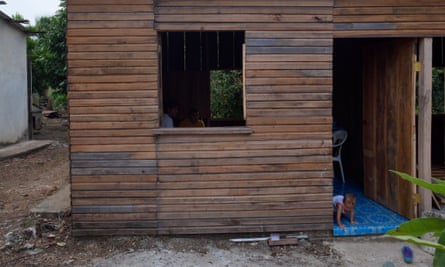
The government’s stance means that some would-be asylum seekers are too scared to seek protection – and may even be forced to return home to dangerous situations, said Kelleen Corrigan, a UNHCR protection officer.
“Hidden people are vulnerable people, so it’s a priority to understand the magnitude of the issue and help the government fulfil its international obligations to identify refugees more quickly by setting up a fair and efficient system,” she said.
Yet there’s little incentive for them to come forward, as many would be rejected under current government policy.
This includes strict retrospective application of a 14-day rule which gives people two weeks to apply for asylum – even though many are traumatised, don’t speak English or don’t understand the system.
Williams accuses UNHCR of unfairly pressuring Belize.
“The government is aware of its obligations but there can be no microwave solution just because there are international mandates and agendas to meet,” she said.
The current stalemate comes amid growing fears that Trump’s anti-immigrant policies will prompt more Central American refugees to seek safety closer to home.
Mexico is expecting more than 20,000 asylum applications this year – almost quadruple the number in 2015 – and it seems inevitable that more refugees will head to Belize.
At Benque Viejo, the busiest land crossing with Guatemala, 8,355 Salvadorans crossed legally in 2016 – a 23% rise on 2014. There was a 12% increase in Hondurans over the same period, though they mostly arrived by boat.
It’s unknown how many cross the porous border unlawfully, said Nikolai Zelaya, deputy port commander.
Minutes later, Zelaya arrested a Honduran man scrambling along the Mopan river bank. He was detained pending an investigationand could face a six-month jail term or US$500 fine.
The highway heading north is flanked by citrus groves and fields of sugarcane, framed by lush rolling hills on the horizon. On the roadside, an Amish farmer loads his horse-driven wagon next to Mayans hawking tropical fruits.
Ten miles from the capital, Belmopan, is the rapidly expanding Spanish-speaking village Armenia, which was established for refugees in the early 1980s.
Reina Morales, 66, from Guatemala, was one of the first settlers. “We found peace here and never left. The new people are looking for the same thing,” said Morales, relishing the cooler twilight air on her veranda after a stifling day.
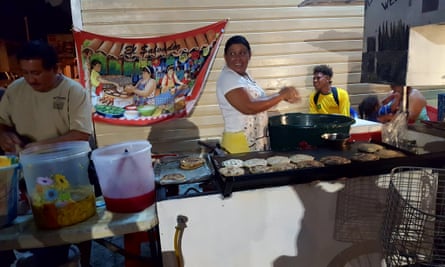
All around, neighbours are building tiny wooden huts to house newcomers such as Ruben Chong, 23, from Honduras, who lives with Morales’ granddaughter Tanya and their infant daughter.
Chong – who asked to be referred to with a pseudonym – first came here in 2012 after his brother was abducted and found decapitated. Six months later, another brother, a taxi driver, was also murdered.
Chong obtained temporary work visas and found employment on a citrus farm.
But in 2015, a cash-for-visas scandal triggered widespread outcry and the subsequent government crackdown threw the work programme into disarray.
Jobless without a visa, Chong returned to Honduras, but was threatened by the same gang who killed his taxi driver brother.
He escaped back to Belize in early 2016, and this time registered for asylum with local NGO Help for Progress, which was authorized to receive applicants while the government revived its dormant refugee scheme.
In the past year the refugee eligibility committee has recommended 75 cases be granted asylum. But none have been approved by minister Williams, so they remain in limbo, unable to work.
Melanie Smith, sociologist and migration expert at the University of Belize, said the government was dragging its feet because Central Americans have been cast as social pariahs.
“This is not a priority for the government; they won’t act unless there is international condemnation.”
Chong, a victim of gang violence, is frantic. “I’m stuck between yes and no. I can’t provide for my family, but I can’t go home,” he said.
